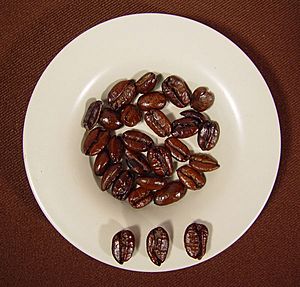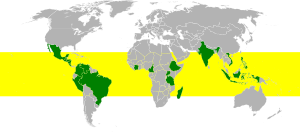Coffee production in the Philippines facts for kids

The Philippines has a long history with coffee, a popular drink enjoyed by many around the world. It's believed that coffee first arrived in the islands around 1696, brought by the Dutch. However, some think it might have been here even earlier, possibly through trade with the Islamic world, where coffee was already popular.
Coffee was once a very important industry in the Philippines. By the 1800s, the country was the fourth largest coffee producer globally! Today, the Philippines produces about 25,000 metric tons of coffee each year. But Filipinos love coffee so much that they consume about 100,000 metric tons annually, meaning a lot of coffee needs to be imported.
The Philippines is special because it's one of the few countries that grows all four main types of coffee. These are Arabica, Liberica (also known as Barako), Excelsa, and Robusta. Most of the coffee grown in the country, about 90 percent, is Robusta. There are ongoing efforts to help the Philippine coffee industry grow even stronger.
Contents
History of Coffee in the Philippines
How Coffee Arrived
Coffee was first planted in the Philippines as early as 1730. A Franciscan friar planted the very first coffee tree in Lipa, a town in Batangas province. The coffee seeds he used came from Mexico.
Other friars, Elias Nebreda and Benito Varas, helped spread coffee farming to other parts of Batangas. Soon, coffee farms became a big part of Batangas' economy. Lipa became known as the "coffee capital" of the Philippines.
Coffee's Big Boom in the 1800s
After the American Civil War ended in 1865, there was a huge demand for Philippine coffee in the United States. It was cheaper for Americans to buy coffee from the Philippines than from Brazil. Barako coffee from Batangas was shipped all the way from Manila to San Francisco.
Coffee also started to be sent to Europe after the Suez Canal opened in 1869. This canal made shipping goods much faster. By 1880, the Philippines was the fourth largest exporter of coffee beans in the world!
Between 1887 and 1889, the Philippines was actually the only source of coffee in the world. This happened because a plant disease called coffee rust badly affected coffee farms in other big producing countries like Brazil, Africa, and Java. This made Philippine coffee, especially Kapeng barako|Batangas barako, very valuable.
Challenges and Decline
Sadly, in 1889, the same coffee rust disease that hit other countries reached the Philippines. This, along with more insect problems, destroyed almost all the coffee trees in Batangas. By 1891, the country's coffee production dropped to just one-sixth of what it was two years earlier.
Because of this, many farmers in Batangas had to switch to growing other crops. Some surviving coffee seedlings were moved to Cavite, a nearby province, which then started to grow more coffee.
Bringing Coffee Back (Post-World War II)
After World War II, in the 1950s, the Philippine government worked with Americans to bring in new types of coffee plants. These new varieties were stronger and more resistant to diseases.
Around this time, instant coffee also started to be made in large amounts, which made the demand for coffee grow even more. Many farmers began planting coffee again in the 1960s. The Philippines even joined the International Coffee Organization (ICO) in 1980, which helps manage the global coffee trade.
Coffee Today in the 21st Century

The demand for coffee in the Philippines has continued to grow. In 2002, Filipinos consumed about 75,000 metric tons of coffee each year. By 2018, this number jumped to 170,000 metric tons annually!
Because local farms don't produce enough coffee to meet this high demand (only about 35,000 metric tons annually), the Philippines now imports a lot of coffee. Most of this imported coffee, about 75,000 to 100,000 metric tons, comes from Vietnam and Indonesia.
Today, Mindanao is the leading region for coffee production in the Philippines, with Sultan Kudarat being the top province. Some traditional coffee-growing areas like Cordillera and Calabarzon have seen their production drop due to strong typhoons.
Even with challenges like the COVID-19 pandemic and the Taal Volcano eruption in 2020, there's new hope for Philippine coffee. For the first time ever, a locally grown coffee won the Philippine National Barista Championship in 2020!
The government has also created a "Philippine Coffee Industry Roadmap 2017-2022." This plan aims to greatly increase the country's coffee production, hoping to make the Philippines more self-sufficient in coffee by 2022.

